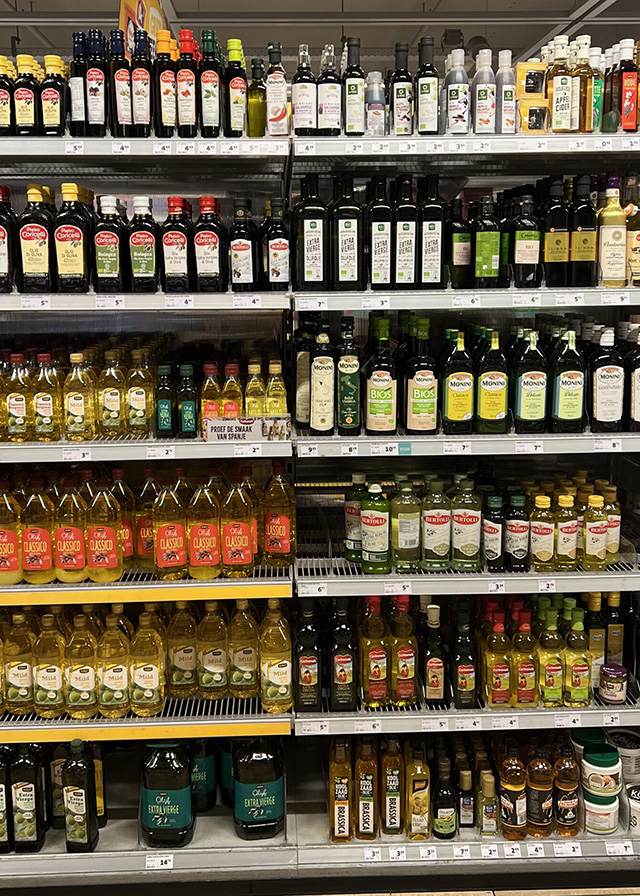
Albanian Pastiçe: Easy baked pasta recipe
Discover Albanian pastiçe: bucatini with feta and eggs baked into a golden pie—simple, nourishing and perfect for hectic days.
Olive oil is a natural product that is treated with care by everyone in the chain. You could say that the quality of extra virgin olive oil is central from tree to table, with every step being surrounded with care.
The color and taste, although dependent on the type of olive, can range from light yellow to deep green and from buttery to grassy, and you even feel a peppery sensation in the back of your throat.

Extra virgin olive oil is obtained by the first, cold pressing of olives as shortly as possible after picking. During picking and transportation, olives always get slightly damaged, increasing acidity. Therefore, the lower the acidity of olive oil, the higher the quality.
Chemically, the presence of these free fatty acids can be explained by a reaction (lipolysis) that starts when enzymes (naturally present in the pulp and pit of the olive) come into contact with the oil (normally enclosed in a vacuole) due to the damage to the olive. This partially converts the olive oil into oleic acid.
The European Commission has established some definitions to make it clear to consumers which quality of olive oil corresponds to which level of acidity.
Large olive oil producers supply many large supermarket chains, which always put pressure on prices to keep them as low as possible. Unfortunately, this often comes at the expense of the quality of the olive oil.
Under pressure, everything becomes fluid, as the saying goes, and that is also the case here. These producers perform a second and sometimes even third pressing on the olive pulp, using heating and even chemicals. The result is, of course, an olive oil that is almost unsuitable for consumption. It is almost lampante oil.
But these manufacturers have come up with a trick: they mix that trash, which they call olive oil, with just enough extra virgin olive oil to meet the important limit of 0.8 grams of free fatty acids per 100 grams. This oil is on the shelves in the supermarket as extra virgin at a very attractive price.

Moreover, the label often contains many falsehoods. A sample by the Olive Oil Institute at the three largest Dutch supermarkets showed that 74% of the bottles of olive oil labeled as extra virgin do not meet the labeling requirements. In some cases, it was so bad that the quality of the olive oil should have been labeled as lamp oil (lampante) and no longer suitable for human consumption.
The Olive Oil Institute is so important because it guarantees the quality of olive oil. This ensures that there is real extra virgin olive oil in the bottle and not an industrial by-product that barely meets the minimum standards. For more information, see here.
That supermarket oil lacks everything that makes good olive oil so healthy. Even the delicious smell and taste are gone. Smell such a bottle and you will find that the extra virgin olive oil often smells like wet cardboard or nothing at all. Nothing remains of that buttery to grassy smell.
Aljeta’s extra virgin olive oil is everything that supermarket olive oil is not. Aljeta does have that love for the natural product. No wonder that an independent producer like Aljeta has received the GOLD label from the leading Olive Oil Institute.
According to the Olive Oil Institute, Aljeta’s extra virgin olive oil is of ‘excellent quality in terms of taste, complexity, and harmony’.

Good extra virgin olive oil costs €7 to €10 per liter in bulk purchase, and that price continues to rise every year. Then there are the costs of filling, labeling, and transportation.
Such perfect extra virgin olive oil is therefore worth a bit more than that ‘olive oil’ from the supermarket.
For more in-depth information about the quality of olive oil and misleading labeling, check out the findings of Keuringsdienst van Waarde. Read more articles about olive oil and supermarket fraud at: Keuringsdienst van Waarde – Olijfolie

Discover Albanian pastiçe: bucatini with feta and eggs baked into a golden pie—simple, nourishing and perfect for hectic days.

The flag of Albania is more than just red and black. This article explores the deeper meaning behind its national symbols – from the double-headed eagle to the traditional ‘Shqiponja’ hand gesture, the unique Albanian language, and the country’s rich cultural heritage. A story of pride, identity, and history captured in one powerful symbol.

This homemade chili oil with Extra Virgin olive oil is a flavor bomb that’s also great for your health. Easy to make and incredibly versatile.

Albania is home to thousands of medicinal plants. Discover how traditional herbal wisdom not only impacts lives, but also shapes a unique export industry.

Despite an increase in risk factors such as an unhealthy diet and less physical activity, cardiovascular mortality in Spain remains surprisingly low. What explains this mysterious ‘Spanish Paradox’? Discover how a key element of the Mediterranean diet plays a crucial role.

The Albanian olive harvest is severely impacted by a labor shortage, leading to a significant decline in olive oil production and exports. In the first nine months of 2024, exports dropped by 60% compared to the same period in 2023. This not only poses challenges for the domestic market but also hinders Albania’s position as an emerging olive oil producer.